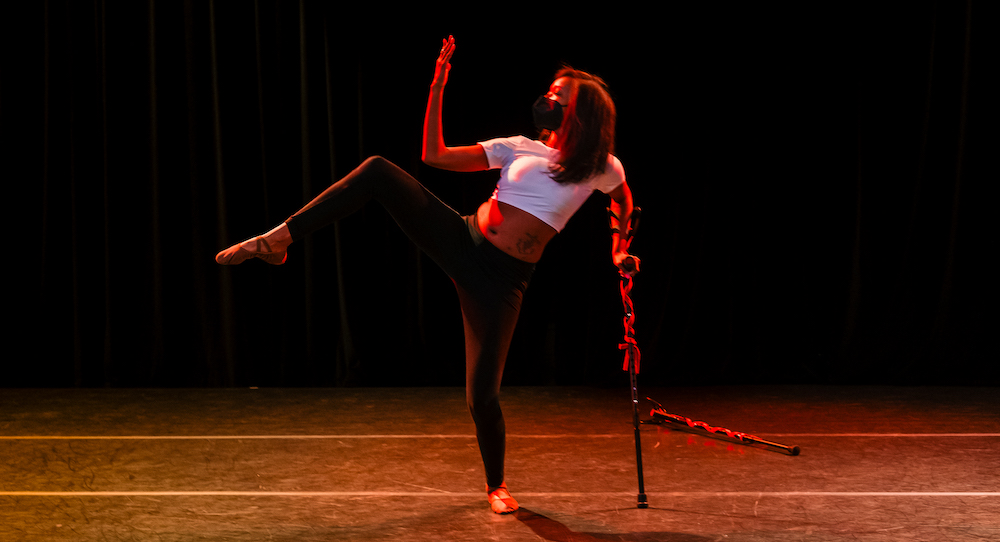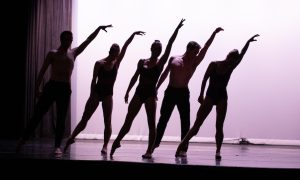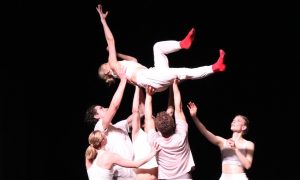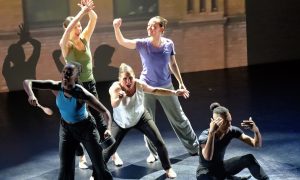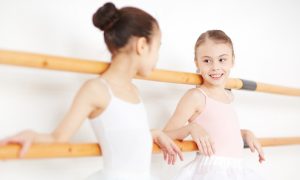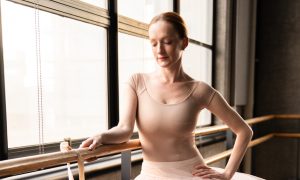Multicultural Arts Center, Cambridge, MA (viewed virtually, via YouTube, synchronously).
April 21, 2024.
“The arc of the moral universe is long, but it bends towards justice,” famously affirmed Dr. Martin Luther King Jr. In other words: work towards a better world can take a while to make an impact, but make an impact it does. Talk to just about any advocate, activist or organizer – on any issue out there – and they’ll affirm that their work is a marathon, not a race.
Many artists will say the same, à la Twyla Tharp’s The Creative Habit; the important thing is keeping at it, because the necessary “elbow grease” doesn’t bear creative fruit immediately (nothing like it).
Abilities Dance Boston (ADB) illustrates such stalwart “keeping at it,” in both advocacy and art-making. The company maintains a commitment to making work that highlights the stories of those in marginalized communities, as well as partnering with organizations and lawmakers advocating for those communities. Part of that work is shining a light on others doing this work: allowing us to learn, support and be inspired. The company’s Intersections series has done just that, telling the stories of artists and advocates both living and posthumous – dubbed “honorees”.
In V3 (third installment) of this series, the stories educated and galvanized, while a multimedia approach captured a variety of aesthetic senses and sensibilities. A cohesive integration of video and real-time dance struck me as quite innovative, and potentially instructive for dance and other live arts as we move forward from all that the COVID pandemic has brought.
The first honoree that the program celebrated was Christopher Unpezverde Núñez, a visually-impaired artist who has found significant healing and empowerment in the art of dance. Like with many other honorees, the program presented interview footage – an authentic window into work and humanity. In stories depicting how contemporary challenges and injustices are interwoven with identity, such as climate change and migration, Unpezverde Núñez asks his dancers “to work from personal experience…intimate experiences.”
As he spoke, video also played of Carmen Rizzo moving here in a studio, there in a room – wearing everyday dance clothes. The “bare bones”, “no frills” feel here aligned with the personal, “intimate” sense that Unpezverde Núñez described – not to mention a quality that resonated throughout the overall program. Rizzo also moved with both vulnerability and ferocity, her technique the most stable of foundations for her kinetic explorations. There was also an understated softness to her movement; she seemed to feel no need to “prove” a thing.
This blend of qualities continued as she danced onstage – just her in a white top and black pants, moving with all of that ferocity and softness. Audio description (by ADB Director Ellice Patterson, edited by Amber Pearcy) noted another connection of interviewee and dancer, making it all the more fitting; both have migrated to the U.S. As a motif, Rizzo shifted from forearms crossed, bending deep, and then lengthened her limbs and found more space. She moved through and past the limitations that she encountered, with both fortitude and fluidity.
Next came a look into Jerron Herman’s story, one of advocating for oneself and finding a path as a dancer with cerebral palsy. In his interview, he described the courage of stepping up during creative process – and having an impact on the work through that. Dancers Kylie Kean and Kate O’Day moved in the studio, on video: mirroring the exchange between Herman and collaborators, between ability and disability.
These movers found close connection through unison and canon. They built a gesture of pulling wrists inwards and then pushing them away — self and other, inner and outer. They juxtaposed circular rolling and more angular, linear pathways – the same of a wheelchair.
One of them circling under the other, they created a sense of collaboration in community – the sort of “space where you’re not expected to speak well, but just to exist” that the audio description shared. Such an environment can even encourage “bringing the funk in,” which the audio description also noted: fun and joy, simply put. Kean and O’Day concluded the piece in physical stillness, in pause – also underscoring the place of rest.
The next honoree was Alicia Alonso, famed Cuban ballerina who experienced visual impairment in her later life and career, yet nevertheless continued to make a resounding impact in dance and beyond. Having passed away in 2019, of course Abilities could not interview her for this program. Instead, narration detailed some highlights of her life and professional legacy. Abigail Ripin then danced in real time, offering balletic vocabulary to align with Alonso’s truest movement love and passion.
Yet, Ripin also infused more contemporary release and ease through spiraling turns. A reflective, internal bearing was also clear in her performance – “inviting us to ponder what deeper connections to the disabled community that Alicia might have had,” per the audio description. “Half is history and half is conjecture” – but Alonso’s dedication to the art form, and to students of the school that she founded, is inarguable.
The story of another posthumous leader, disability advocate and thought leader Stacey Park Milbern, came before intermission. Linda Lin danced to represent her life and work: in education, lawmaking, entertainment, and beyond. She moved with a lovely sense of tension and its subsequent release. The movement vocabulary was pedestrian, with Taylor-esque stepping and running, yet also beautifully rich.
She rolled wrists while turning, then created a symmetrical wave-like shape through her upper body as she knelt. Through such fluid, layered gesture and shape, Lin underscored the high level of complexity and action in Milbern’s far too-short life (as the preceding video noted, she passed away on her thirty-third birthday).
The continuity and resonance of Lin’s movement paralleled how Milbern’s legacy continues through the impact of the ongoing policy that she helped realize. “Offering this moment to past, present and future” said the audio description as Lin again crossed her wrists and then opened her arms to the audience: pure poetry in movement and words.
Directly following intermission, the honoree at hand was Kayla Hamilton. In her video interview, she described childhood experiences within nature and beginning dance. Her parents pushed her to be active – both a gift and a challenge, also considering how that intersected with her disability, she explained. Dancers Kylie Kean and Kate O’Day – first on camera and then onstage – depicted this story through natural imagery and their relationships in space: converging, diverging and much more.
They also created a pleasing sense of continuity through their turns, yet also accent through throwing limbs and grounding in lunges. They mirrored their shapes and staging, creating even more satisfying contrast – complexity like that which Hamilton described in her story.
“A moment of radical nothingness,” per the audio description, was another highlight on the importance of rest, of being. It brought me back to Hamilton’s story; she was grateful for being pushed to do more, yet there was also an unspoken sense of loss in Hamilton’s story, the lack of ability to rest and to just be.
Next, we heard from Alice Sheppard, of Kinetic Light. She also described childhood experiences — learning a lot through books but also seeing big differences between what she encountered there and her own life experience. She described how her journey involved the exploration of both dance – in the academic, formal sense – and the more investigative artistic process. Ellice Patterson danced this story (fully onstage in this section).
As in the prior work, Patterson created some of the natural images that Sheppard described from her childhood, such as the fluidity of willow tree branches. Motions of opening, lunging, rising and bending illustrated Sheppard’s highly intentional embodiment. The abstraction at hand also aligned with the sense of open questions that she surfaced: of continued exploration, process over product, of questioning the supremacy of the final product and instead honoring the path itself.
“I’ve had a lot of difficulties, but those that have been beautiful in so many ways,” shared the final honoree Yaffa: a sense of hope and gratitude even through the immense challenges in their life, as a displaced Palestinian and nonbinary person. They conveyed joy through how their work can raise funds for, and shine a light on the stories of, those with whom they share those experiences.
As with other honorees, memories of encountering the natural world were salient to them. Through the work of creating greater equity and justice, artmaking, and the intersection of those two endeavors, the calm and grounding of nature can always be fortifying.
Movers on video – Cassandra Charles, Claire Lane and Dara Capley – created that grounded sense, but also reached out and were absorbed into their spaces. Next dancing before us in real time, the trio shifted from a wistful, joyful sense in the body to something heavier – thus embodying the weight of displacement. This work was a great choice for a closer, as it offered perhaps the strongest movement vocabulary and performance in the program.
The trio “sent pulses of liberation,” as the audio description put it, with percussion on floor – an idea that vibrated deep into my bones. Shaping the imagery of the wheatgrass and olive trees in Yaffa’s story, their arms snaked around their torsos and their legs waved backwards. Repetition gave the sense of continued struggles, but continued reaching towards something better.
A final sense of grounding in space made me remember what Yaffa had poetically affirmed: “home is wherever we are.” The work continues to make wherever that it is more vibrant, more liberated, more equitable – through art and other means. It truly is a marathon, not a sprint. Thankfully we have community, collaboration, and inspiring individuals to keep us running. Thank you Abilities Dance Boston, as always, for those reminders!
By Kathryn Boland of Dance Informa.


